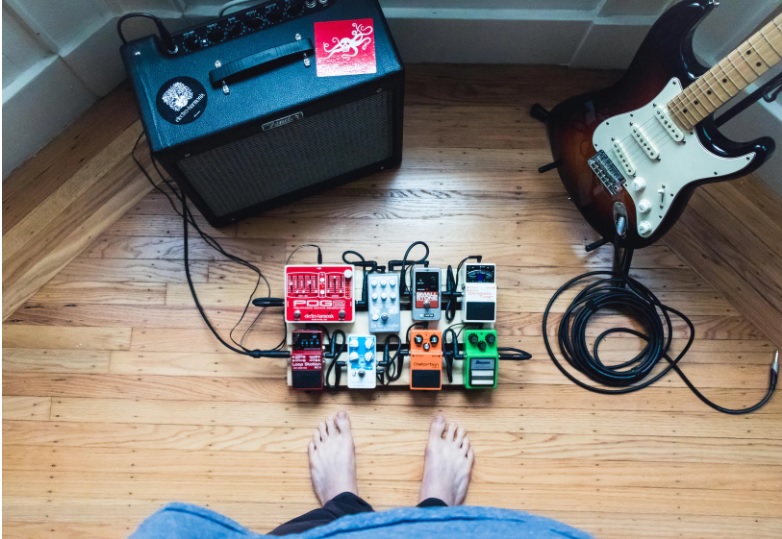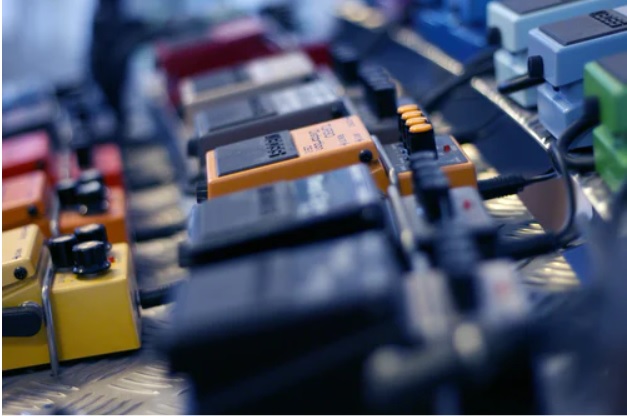Pedals are guitar effects units that attach to the guitar and alter one or more aspects of the guitar’s signal. They often generate their effect by changing the guitar’s tone, but some pedals do other things, such as control a guitar’s volume or wah-wah its sound. Some guitarists call them “stompboxes,” because they step on them while playing with their feet. The article then goes into detail about different types of pedals and how to use them for advanced players.
Noise Suppressor
A noise suppressor is a guitar pedal that eliminates guitar amplifier hiss, hum from the guitar pickups, and buzz created by electrical problems. In this case, consider a noise gate pedal that will effectively suppress unwanted noise. This is used often in recording studios when many different instruments are playing together or if an instrument has a high gain setting, such as with overdrive pedals.
Delay
Delay is one of the most common types of guitar pedals, and it is intended to mimic the natural echo that takes place in an acoustic guitar. This effect is achieved by amplifying the guitar signal and rapidly turning down its volume to play it back after a short delay, usually somewhere between 50 milliseconds or 30 seconds. The resulting sound causes either slapback, where the loudness of each note decays rapidly before another one can be played, or echo, where the guitar signal is repeated and delayed.
Delay pedals come in a few different types such as the digital delay, which is usually an option on most guitar effects processors, the analog delay which is typically old-fashioned sounding, and the analog tape delay. Digital delays do not reproduce natural echoes but, instead, use a very short sample of the sound that is repeated a set number of times in succession. These delays are called “tap” because the guitar player must tap their foot on a button with rhythm to match the tempo at which they want to play back the notes, usually once every beat or bar.
Wah-Wah Pedal
A wah-wah pedal or simply wah pedal is an electric guitar effects processor that allows musicians to modify the tone of their guitar. The name comes from its actuation by a foot treadle, which moves a potentiometer on an electric guitar’s volume/tone circuit, causing it to sweep between lower and higher tones with increasing frequency.
Tremolo Pedal
A tremolo pedal or whammy bar is an effects unit that causes varying amounts of “dips” and “rises” in the volume of a guitar signal by shortening and lengthening the vibrating length of the guitar strings and sometimes other parameters, such as ‘tension’ for acoustic guitars. The result to the listener’s ear is a sound that goes from normal guitar sound to a “warbling” trill or, in extreme settings, even total silence.
Compressor
You can also consider the use of a compressor to add sustain and punch to the guitar in a subtle way. Compressors work by reducing the dynamic range of an audio signal, which makes them ideal for guitars, as it reduces any unwanted sonic peaks created when playing guitar solos or guitar riffs. The MXR M87 is one such guitar compressor pedal that adds natural-sounding compression to your sound without compromising the guitar tone.
This guitar pedal effect will also work well to reduce any unwanted noise that can occur when playing guitar, especially if you are using high gain or distortion guitar effects pedals. Another popular guitar compressor is the MXR Dyna Comp, which uses an old-school design approach with a single knob to control the amount of compression applied to your guitar sound.
A guitar compressor pedal can be used to create some interesting guitar effects, such as adding sustain and punch during solos or bringing out low-end bass sounds when playing riffs. However, guitar compressors are not something you would use all the time on your guitar, so it is recommended that you experiment with different guitar pedal compression settings to find guitar effects that work best with your guitar sound.

The tone of your guitar will determine the type of effect you want. For example, if you are looking for a more vintage sound, an analog pedal would be best suited to produce this sound. If you’re interested in experimenting with different types of effects and styles, then it might be worth investing in some high-end pedals that may cost upwards of $200 or more.
On the other hand, if all you need is something simple like reverb, delay, or distortion without any fancy features, look into cheaper options on sites such as Amazon where they can range from about $20-$50 depending on what kind of quality level suits your needs. All these are geared towards ensuring that you use the right type of pedal to suit your needs.
























